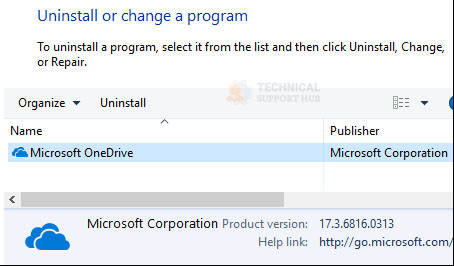
- #REINSTALL ONEDRIVE WINDOWS 10 START OVER INSTALL#
- #REINSTALL ONEDRIVE WINDOWS 10 START OVER UPDATE#
- #REINSTALL ONEDRIVE WINDOWS 10 START OVER FOR WINDOWS 10#
- #REINSTALL ONEDRIVE WINDOWS 10 START OVER PROFESSIONAL#
You might not see the OneDrive icon in the notification area go away until you move your mouse over that area.ĭo not close the “ Command Prompt” window yet. Follow the “ /im” parameter with the name of the process, or image, which is “ OneDrive.exe” in this case. The “ /f” parameter forcefully terminates the process and the “ /im” parameter specifies the image, or process, name.

Type the following command at the prompt and press “ Enter“. To open the Command Prompt window, press the “ Windows key+X” to open the Power User menu and then select “ Command Prompt“. We need to kill the OneDrive running process before we can uninstall OneDrive. If you haven’t updated to the Windows 10 Creators Update, you’ll have to use the Command Prompt to uninstall OneDrive.
#REINSTALL ONEDRIVE WINDOWS 10 START OVER UPDATE#
Uninstall OneDrive In Windows 10 Prior To The Creators Update Once OneDrive is installed and running again, you’ll have to click the OneDrive icon in the notification area and sign in to your Microsoft account. To remove OneDrive from File Explorer, follow the procedures in the “ Remove OneDrive From File Explorer By Changing The Registry” section or the “ Remove OneDrive From File Explorer Using a Registry (.reg) File” section above. If you delete the files in the OneDrive folder on your computer, the files will still be in your OneDrive account online. When you uninstall OneDrive, the OneDrive folder in File Explorer’s navigation pane is still there as a normal folder (e.g., “ C:\Users\Lori\OneDrive“) with the files that had synced to your computer. Click the “ X” button in the upper-right corner of the dialog box to close it. Microsoft OneDrive is removed from the “ Apps & features” screen in the Settings. We don’t recommend disabling UAC entirely, however. NOTE: You may not see this dialog box, depending on your User Account Control settings. If the “ User Account Control” dialog box displays, click “ Yes” to continue. The results display as you type.Ĭlick on “ Microsoft OneDrive” in the list of results, and then click “ Uninstall“.Ĭlick “ Uninstall” on the confirmation pop-up that displays. In the search box on the right, type “ onedrive” (without the quotes). On the “ Apps” settings screen, make sure “ Apps & features” is selected in the left pane. On the “ Windows Settings” dialog box, click “ Apps“. To uninstall OneDrive, open the Start menu and click the “ Settings” (gear) icon.

That way you can easily enable it again if you need it.
#REINSTALL ONEDRIVE WINDOWS 10 START OVER PROFESSIONAL#
If you’re running Windows 10 Professional or Enterprise, we recommend using the Local Group Policy Editor to disable OneDrive. Disabling Via The Local Group Policy Editor
#REINSTALL ONEDRIVE WINDOWS 10 START OVER FOR WINDOWS 10#
Uninstalling OneDrive is useful for Windows 10 Home users who cannot use the Local Group Policy Editor method listed in the previous section to disable OneDrive.
#REINSTALL ONEDRIVE WINDOWS 10 START OVER INSTALL#
NOTE: We don’t recommend completely uninstalling OneDrive, although you can install it again. Uninstall OneDrive In The Windows 10 Creators UpdateĪs of the Windows 10 Creators Update Version 1703 (or, more specifically, Windows 10 Build 14986), Microsoft OneDrive is finally listed as a standalone app in the “ Apps & features” section of the Settings app, allowing you to completely remove OneDrive from Windows easily. To enable OneDrive again, simply select “ Not configured” or “ Disabled” on the property dialog box. Sign out of Windows and back in, or reboot, for the change to take effect. To close the Local Group Policy Editor, go to “ File” > “ Exit” or click the “ X” button in the upper-right corner of the dialog box.


Select the “ Enabled” option at the top of the dialog box and click “ OK” at the bottom. Then, in the right pane, double click on “ Prevent the usage of OneDrive for file storage“. In the left pane, navigate to the following folder: Local Computer Policy > Computer Configuration > Administrative Templates > Windows Components > OneDriveĬlick on the “ OneDrive” folder. Then, type “ gpedit.msc” (without the quotes) in the “ Open” box and click “ OK” or press “ Enter“. To open the Local Group Policy Editor, press “ Window key+R” to open the “ Run” dialog box. If other people use your computer, make sure they are not using OneDrive before you disable it. NOTE: When you disable OneDrive using the Local Group Policy Editor, it is disabled for all users on your computer. It also overrides removing OneDrive from the File Explorer by changing the registry. It stops OneDrive from syncing with the cloud or connecting with other apps, and removes OneDrive from the navigation pane in File Explorer. This procedure does not uninstall OneDrive. If you’re using Windows Professional or Enterprise, you can use the Local Group Policy Editor to disable and remove OneDrive. Disable & Remove OneDrive Using The Local Group Policy Editor reg files (32-bit or 64-bit) and click through the same dialog boxes listed above. To add OneDrive back to the navigation pane in File Explorer, double-click on one of the “ Restore”.


 0 kommentar(er)
0 kommentar(er)
